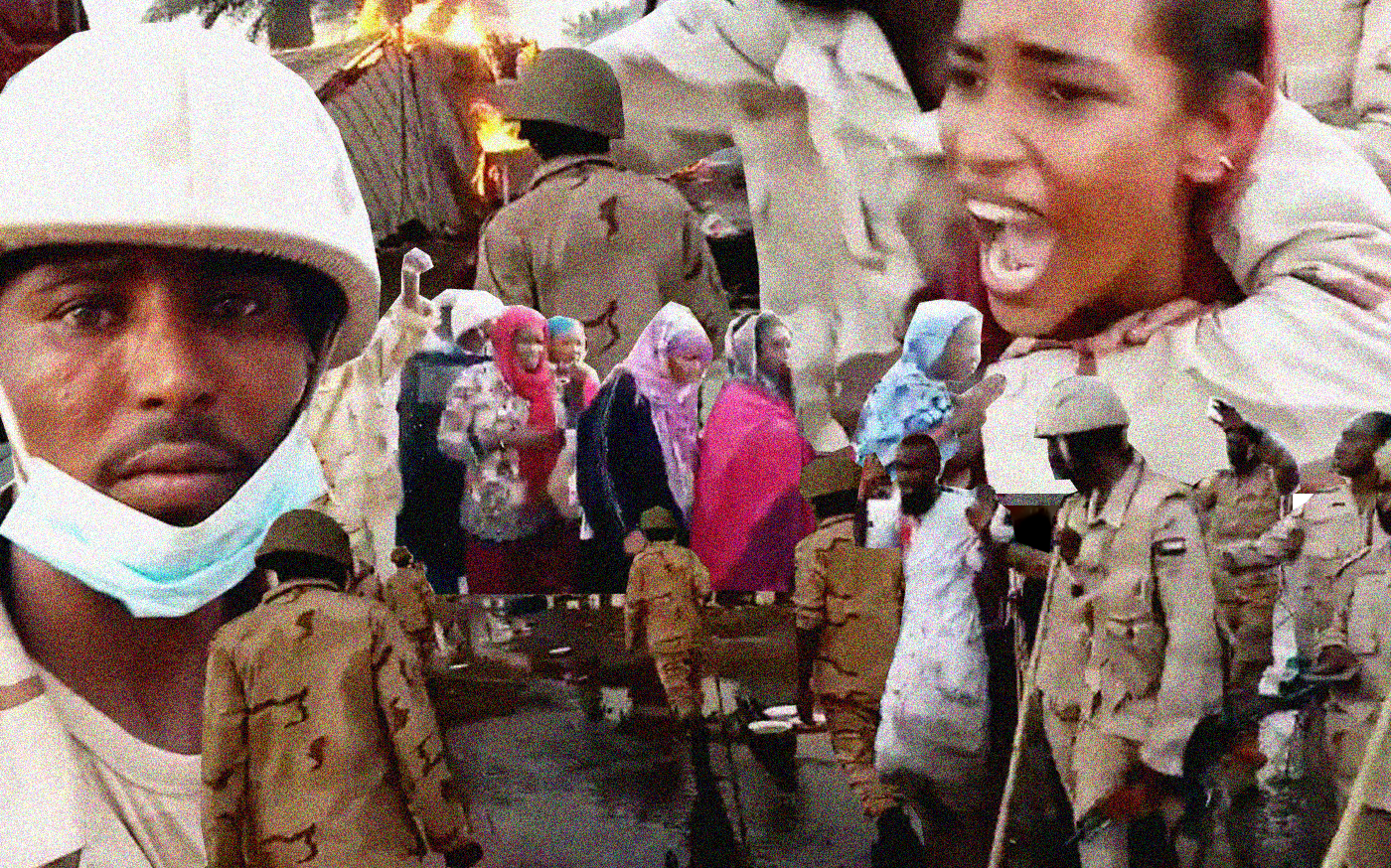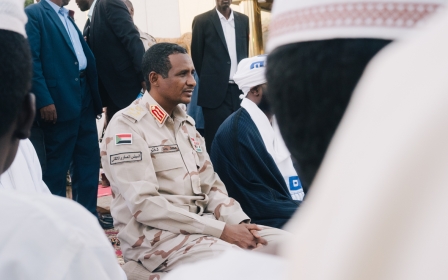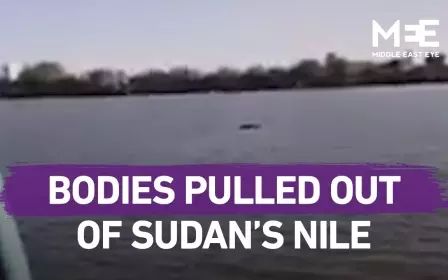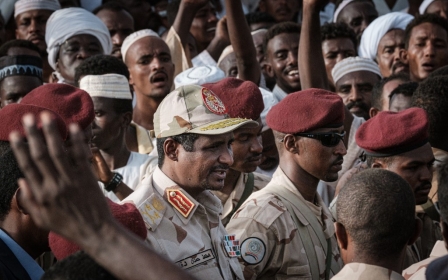'They felt victorious': How Sudan's militiamen filmed their deadly assault on protesters

Tents burn and bullets crackle in the background as fighters from Sudan's feared Rapid Support Forces giddily round up protesters, bringing canes down on their backs, pressing boots onto their throats and then skipping, apparently in delight, as they move on to new victims.
These images were captured by the fighters themselves as they tore through the site of a peaceful sit-in in Khartoum on 3 June, where more than 100 protesters were killed. Some of their bodies were thrown into the nearby Nile by Sudanese forces, according to reports received by the Central Committee of Sudan Doctors.
Most of the images emerged as part of a deluge of footage last week that flooded social media when an internet blackout imposed after the attack ended.
'It was as if they won a war'
- Sudan Ombudsman
Much of that footage was shakily shot by terrified protesters trying to document the violence while also running from the bullets and usually showed advancing RSF fighters or police in the distance. The footage from the RSF themselves, fighters mostly drawn from the notorious Janjaweed militias of Darfur, is very different.
Filmed from a first-person perspective as they walk through the dispersed campsite, turning on the protesters they have captured, the footage is more stable and often clearly shows the faces of the fighters involved.
New MEE newsletter: Jerusalem Dispatch
Sign up to get the latest insights and analysis on Israel-Palestine, alongside Turkey Unpacked and other MEE newsletters
"They weren’t afraid or ashamed. They felt victorious for some odd reason and wanted to get it on tape," Azaz Elshami, a Sudanese human rights advocate, told Middle East Eye.
"They filmed all their actions - including raping women, according to sexual abuse victims. They know they are not accepted and not seen as part of this revolution and it was their chance to take revenge."
Build-up
The attack started at 5 am on 3 June. The lights were cut the night before, according to eyewitnesses. Protester videos showed pick-up trucks carrying heavily armed fighter trucks building up on the edges of the sit-in and on the perimeter of the military headquarters where protesters were camping outside.
Another video reportedly from the morning of the attack, apparently shot from a similar pick-up truck and behind a group of uniformed officers, showed hundreds of fighters marching towards the sit-in.
A voice from behind the camera yells encouragement, yelping excitedly and shouting "forward", at the fighters who were all dressed in the RSF's desert fatigues, wearing helmets and carrying canes but not carrying guns. It was these fighters who later spread through the sit-in.
MEE geo-located the location of the video to the northern side of the Blue Nile Bridge, which crosses the river and leads directly from Bahri, Khartoum's sister city, into the area outside military headquarters.
'Civilian or Military?'
Unlike the images shot by the protesters when the sit-in was first besieged, most of the footage shot by RSF fighters released in the past week appears to have been taken after the initial raid was completed, when protesters were being rounded up.
There is less footage from the protesters themselves of this period, when the military had taken full control of the area and when continued abuses allegedly happened, including rape, tent burning and the disposal of bodies in the Nile.
The triumphant fighters roamed the deserted sit-in demanding the remaining protesters shout "military" instead of the "civilian [rule]" slogan they would have been roaring only hours earlier, recordings show.
One of those fighters filmed an eight-minute clip, starting on the northern side of the sit-in, near where troops entered from the Blue Nile bridge, before walking south towards the University Mosque. He then turns left, near the Technical School where a group of artists had been based and where Sky News later reported the smell of decaying bodies.
In one video shot near the centre of the sit-in, near the University Mosque, a soldier holds the neck of a woman who has been separated from a larger group of detained women. Other soldiers encircle her, hounding her to shout "military". She initially resists but her face betrays growing fear as more men gather and, eventually, she screams the response they demand.
"What struck me the most was the fact that the soldiers doing the dirty work are mostly young. Led by more senior officers and they attacked the protesters as if they were enemies of the state. They were shooting to kill," said the person behind the Twitter account Sudan Ombudsman, which has organised hundreds of videos and images of violence against protesters.
"What is even more striking is how jovial they were after breaking the sit-in. It was as if they won a war."
Other scenes shot by a different fighter from the same site, where tents that had housed protesters who had travelled in from outside Khartoum were now burning, showed elderly men among others having the same demanded of them; a man in a ripped shirt desperately conceding their demand and then sprinting away; and a doctor being marched away by the scruff of his neck. Earlier the same RSF fighter had asked passing protesters whether they were Muslims.
In another location, a clearing behind the sit-in, a group of soldiers catch a man trying to run away and force him to lie down.
They beat him with their canes and a broad tree branch, then press their boots on his throat, demanding he shout "military".
Round-up
After the gunfire that mowed down the crowds at the sit-in's iconic barricades and the following raid of hundreds of fighters on foot, the protesters who could not escape were rounded up.
At least initially, some of them were kept in groups in different parts of the sit-in, with some singled out, including an injured man who had his hands bound and his hair cut off by an RSF fighter, a common tactic used during previous months to humiliate protests.
Many of them were marched to an area under the Blue Nile bridge, where the attack had started and where protesters were held before being trucked off. It was very close to the location of this video that volunteers later recovered a man's body from the Nile.
There, the soldiers made the same demand that protesters shout "military" while others mocked the protester chant "fall or no fall, we're staying here".
The footage shows the protesters sat on the ground surrounded by RSF fighters, some of them bound and lying face down.
Selfies
At least two of the fighters who filmed the raid on the sit-in turned their cameras onto their own faces, one of them even pulling down his face mask to reveal it in full.
The Sudanese social media users who saw these videos after they emerged on 9 July initially expressed shock at how these fighters seemed to be revelling in the moment, but then immediately decided to use the footage to their own advantage.
They pulled screenshots of those "selfies" taken by the cameramen as well of other fighters pictured in the videos and spread the images on social media, asking people to help identify them. Very little of the documentation captured by the protesters had been shot close enough to clearly identify individuals.
"The celebratory filming by the perpetrators themselves and the accompanying commentary confirms the callous nature of the attack and the premeditated mindset of the perpetrators," a legal activist, who did not want to be named because of security concerns, told MEE.
"Second, the identification of specific participants in these crimes renders them witnesses that can be interrogated if a credible investigation is permitted in the future."
Future evidence
After months of protesting that began with a call for three-decade ruler Omar al-Bashir to step down in December, then turned on the military rulers who replaced him in April, the opposition announced a power-sharing agreement with the military at the beginning of July, a month after the sit-in dispersal.
That agreement has still not been signed, however, and a major point of contention could be the demand for an independent investigation into the 3 June attack, which the military council has admitted it ordered, though it later denied making that admission. The military has been requesting a clause that grants immunity to its members.
The council's deputy leader and RSF commander General Hamdan Dagalo, known as Hemeti, has claimed his troops were not responsible for the violence despite the visible presence of their uniforms, claiming imposters bought RSF fatigues from the markets.
For many, this is why the documentation of the attack has been so important. Its very earliest moments were livestreamed but the internet was quickly interrupted before being cut off almost entirely, limiting the amount of footage that could come out. When the internet was finally restored, more than a month later, a social media campaign to "document the military headquarters massacre" could begin.
An RSF fighter mocks a protester chant as fires burn in the background: "We're going to show them what their solution is tonight."
"The timing couldn’t be better - our pain aside," said Elshami. "Because the TMC [Transitional Military Council] leadership have been trying to deflect and come up with excuses that the massacres were not ordered by them, which is hard to believe when you see the amount of force."
A formal request has also been filed with the International Criminal Court a week after the attack, asking the court's prosecutor to "investigate apparent crimes against humanity".
"I think all this footage will be treated as evidence someday soon when we have a civilian government," said Sudan Ombudsman.
This article is available in French on Middle East Eye French edition.
Middle East Eye delivers independent and unrivalled coverage and analysis of the Middle East, North Africa and beyond. To learn more about republishing this content and the associated fees, please fill out this form. More about MEE can be found here.




